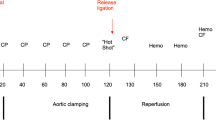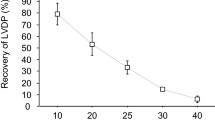Summary
The effects of metabolic acidosis and alkalosis in the initial reperfusate on post-ischemic stunned myocardium were investigated in isolated rat hearts. Metabolic acidosis and alkalosis were produced by altering the doses of artificial buffer (Tris) in place of sodium bicarbonate. All hearts were subjected to global ischemia for 15 min at 37°C. The initial reperfusate under study was given during the subsequent 10 min of reperfusion, just prior to release of the aortic clamp. After that, reperfusion using normal Krebs-Henseleit buffer solution was carried out for 40 min. The acidotic initial reperfusate (pH 6.8) resulted in better protection than the alkalotic initial reperfusate (pH 7.8), as demonstrated by 1) a higher recovery of aortic flow (80.6 % ± 3.8 % vs 32.7 % ± 4.8 %, p < 0.01), 2) a smaller leakage of creatine kinase during the initial reperfusion phase (6.0 ± 0.7 vs 14.6 ± 2.1 IU/10 min/g dry weight, p < 0.05) and during the post-ischemic Langendorff perfusion phase (8.8 ± 1.7 vs 37.3 ±5.2 IU/10 min/g dry weight, p < 0.05), and 3) a lower myocardial water content at the end of reperfusion (84.8 ± 0.2 % vs 85.7 % ± 0.3 %, p < 0.05). Not only Tris buffer system, but also HEPES buffer system indicated that acidotic initial reperfusate was effective to protect against myocardial injury. These results suggest that 1) the extracellular pH during initial reperfusion profoundly influences the reversible myocardial dysfunction (stunned myocardium), and 2) the acidotic initial reperfusate improves post-ischemic myocardial performance.
Similar content being viewed by others
References
Bernard M, Menasche P, Canioni P, Fontanarava E, Grousset C, Piwnica A, Cozzone P (1985) Influence of the pH of cardioplegic solutions on intracellular pH, high-energy phosphates, and postarrest performance. Protective effects of acidotic, glutamate-containing cardioplegic perfusates. J Thorac Cardiovasc Surg 90:235–242
Bing OHL, Brooks WW, Messer JV (1973) Heart muscle viability following hypoxia. Protective effect of acidosis. Science 180:1297–1298
Braunwald E, Kloner RA (1982) The stunned myocardium prolonged, post-ischemic ventricular dysfunction. Circulation 66:1146–1149
Chapman RA, Ellis D (1977) The existence of a Ca2+ for H+ exchange across the sarcolemma of frog cardiac muscle cell. J Physiol (Lond) 265:19–20
Cingolani HE, Mattiazzi AR, Blesa ES, Gonzalez NC (1970) Contractility in isolated mammalian heart muscle after acid-base change. Cite Res 26:269–278
Fabiato A, Fabiato F (1978) Effects of pH on the myofilaments and the sarcoplasmic reticulum of skinned cells from cardiac and skeletal muscles. J Physiol 276:233–255
Follette DM, Fey K, Buckberg GD, Helly JJ, Steed DL, Foglia RP, Maloney JV (1981) Reduction of postischemic damage by temporary modification of reperfusate calcium, potassium, pH, osmolarity. J Thorac Cardiovasc Surg 82:221–238
Gillespie JS, McKnight AT (1976) Adverse effects of Tris hydrochloride, a commonly used buffer in physiological media. J Physiol (Lond) 259:561–573
Hamasaki T, Kuroda H, Mori T (1988) Temperature dependency of calcium-induced reperfusion injury in the isolated rat heart. Ann Thorac Surg 45:306–310
Hearse DJ (1977) Reperfusion of the ischemic myocardium. J Mol Cell Cardiol 9:605–616
Henry PD, Shuchleib R, Davis J, Weiss ES, Sobel BE (1977) Myocardial contracture and accumulation of mitochondrial calcium in ischemic rabbit heart. Am J Physiol 233:677–684
Heyndrickx GR, Baig H, Nellens P, Leusen I, Fishbein MC, Valuer SF (1978) Depression of regional blood flow and wall thickening after brief coronary occlusion. Am J Physiol 234:H653-H659
Jennings RB, Reimer KA (1981) Lethal myocardial injury. Am J Pathol 102:241–255
Jennings RB, Reimer KA (1983) Factors involved in salvaging ischemic myocardium. Effect of reperfusion of arterial blood. Circulation 68: Suppl. 1:25–36
Jenings RB, Reimer KA, Steenbergen C (1984) Myocardial ischemia and reperfusion: Role of calcium, In: Control and Manipulation of Calcium Movement. 272–303, Raven Press
Jennings RB, Schaper J, Hill ML, Steenbergen C, Jr, Reimer KA (1985) Effect of reperfusion late in the phase of reversible ischemic injury. Circ Res 56:262–278
Johannson M, Nilsson E (1975) Acid-base changes and excitation-contraction coupling in rabbit myocardium. Effects on isometric tension development at different contraction frequencies. Acta Physiol Scand 93:295–309
Katz AM (1973) Effects of ischemia on the contractile process of heart muscle. Am J Cardiol 32:456–460
Kloner RA, DeBoer LWV, Darsee JR, Ingwall JS, Braunwald E (1981) Recovery from prolonged abnormalities of canine myocardium salvaged from ischemic myocardial necrosis by coronary reperfusion. Proc Natl Acad Sci USA 78:7151–7156
Kuroda H, Ishiguro S, Mori T (1986) Optimal calcium concentration in the initial reperfusate for post-ischemic myocardial performance. J Mol Cell Cardiol 18:625–633
Lamping KA, Gross GJ (1985) Improved recovery of myocardial segment function following a short coronary occlusion in dogs by nicorandil, a potential new antianginal agent, and nifedipine. J Cardiovasc Pharmacol 7:158–166
Langer GA (1985) The effect of pH on cellular and membrane calcium binding and contraction of myocardium: A possible role for sarcolemmal phospholipid in EC coupling. Circ Res 57:374–382
Lazdunski M, Frelin C, Vigne P (1985) The sodium/hydrogen exchange system in cardiac cells: Its biochemical and pharmacological properties and its role in regulating internal concentrations of sodium and internal pH. J Mol Cell Cardiol 17:1029–1042
Menasche P, Grousset C, De Boccard G, Piwnica A (1984) Protective effect of an asanguineous reperfusion solution on myocardial performance following cardioplegic arrest. Ann Thorac Surg 37:222–228
Nakamura Y, Schwartz A (1972) The influence of hydrogen ion concentration on calcium binding and release by skeletal muscle sarcoplasmic reticulum. J Gen Physiol 59:22–32
Nayler WG (1981) The role of calcium in the ischemic myocardium. Am J Pathol 102:262–270
Nayler WG, Panagiotopoulos S, Elz JS, Daly MJ (1988) Calcium-mediated damage during postischemic reperfusion. J Mol Cell Cardiol 20: Suppl II:41–54
Neely JR, Liebermeister H, Battersby EJ, Morgan HE (1967) Effect of pressure development on oxygen consumption by isolated rat heart. Am J Physiol 212:11804–11814
Nugent WC, Levine FH, Liapis CD, LaRaia PJ, Tsai CH, Buckley MJ (1982) Effect of the pH of cardioplegic solution on post-arrest myocardial preservation. Circulation 66 (Suppl 1):68–72
Philipson KD, Bersohn MM, Nishimoto A (1982) Effects of pH on Na+-Ca2+ exchange in canine cardiac sarcolemmal vesicles. Circ Res 50:287–293
Przyklenk K, Kloner RA (1988) Effect of verapamil on postischemic “stunned” myocardium: importance of the timing of treatment. J Am Coll Cardiol 11:614–623
Przyklenk K, Ghafari GB, Eitzman DT, Kloner RA (1989) Nifedipine administered after reperfusion ablates systolic contractile dysfunction of postischemic “stunned” myocardium. J Am Coll Cardiol 13:1176–1183
Shen AC, Jennings RB (1972) Kinetics of calcium accumulation in acute ischemic myocardial injury. Am J Pathol 67:417–440
Steenbergen C, Deleeuw G, Rich T, Williamson JR (1977) Effect of acidosis and ischemia on contractility and intracellular pH of rat heart. Circ Res 41:849–858
Vogel S, Sperelakis N (1977) Blockade of myocardial slow current at low pH. Am J Physiol 233:C99-C103
Whalen DA Jr, Hamilton DG, Ganote CE, Jennings RB (1974) Effect of a transient period of ischemia on myocardial cells. I. Effects on cell volume regulation. Am J Pathol 74:381–398
Author information
Authors and Affiliations
Rights and permissions
About this article
Cite this article
Matsuda, N., Kuroda, H. & Mori, T. Beneficial actions of acidotic initial reperfusate in stunned myocardium of rat hearts. Basic Res Cardiol 86, 317–326 (1991). https://doi.org/10.1007/BF02191529
Received:
Issue Date:
DOI: https://doi.org/10.1007/BF02191529




